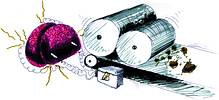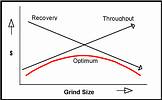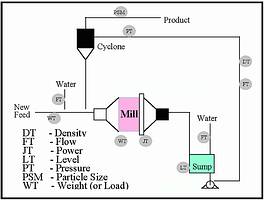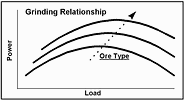

A White Paper by Neil Freeman, Jonathan Luse and Anoop Mathur; from 7th Canadian Symposium on Mining Automation, Fort McMurray, Alberta, Canada
Perhaps the most important component of mineral processing operations is the grinding circuit, where ore is ground to a size conducive to the extraction of the valuable resource contained within it. Grinding circuits are generally the bottleneck of the operation and become the profit-limiting process of the plant. It is therefore important to maximise the throughput of ore, sized in the appropriate range by the grinding circuit for economical recovery.
The proper size range for separating the metal from the waste ore varies depending on the type of metal mined. For example, a typical copper concentrator will attempt to grind ore to between 400 and 35 mesh (74 and 210 microns.) Ore in this size range will successfully separate the copper from the tailings in the downstream in the flotation cells.
There is a trade-off between recovery and throughput. Over-grinding the ore will limit the throughput while under-grinding ore will not be recovered. There is an optimum point on the curve shown in Figure 1 that represents the maximum recovery against throughput.

Optimisation of the grind size, via the throughput/recovery relationship and the control of the grind size, is a vital part of mineral processing operation. The grinding circuit must be operated in a stable and controlled manner to achieve optimum recovery while maximising throughput.
This article introduces the application of both neural networks and multivariable control technologies to grinding circuits. It outlines the basic control objectives, control issues, and how advanced control schemes can help increase the profitability and efficiency of a grinding mill.
Circuit description
The grinding mill illustrated in Figure 2 uses many measurements for controlling the stability and throughput of the operation. There are three physical inputs to the circuit (new feed, and two water additions) and one output (properly sized ore from the cyclone). In addition, the circuit draws power, and measures flow, density, level, weight, and other signals such as particle size. The controller uses these signals to determine the setpoints of the feed rate and water addition for operations.

Control objectives
The success of a mineral processing plant can be gauged by any number of indicators. One of these indicators, and perhaps the most important, is the cost per ton treated. Although there are some notable exceptions, the grinding circuit tends to be the rate limiting operation for minerals processing plants. For these rate limited sites there are several methods to improve performance and profits, including the following:
1. Increase throughput of the milling circuit.
2. Increase recovery by reducing variability from the milling circuit.
3. Improve milling circuit usage.
Where the milling circuit is not the rate-limiting step then improvements in plant performance would be achieved by:
1. Increase recovery by reducing variability from the milling circuit.
2. Minimise the energy requirement for the same grind.
In general the objectives of the grinding circuit are:
1. Achieve a specific product particle size.
2. At this particle size maximise tonnage.
3. Minimise spillages, excursions, and other process upsets.
To summarise, the financial and business objectives would be 'more tons per hour and 'less rands per ton' production.
Grinding circuit control problems
Many issues and challenges are faced in the efficient control of the grinding circuit, whether it is a ball or rod mill, a semi-autogenous grinding (SAG) mill, or an autogenous grinding (AG) mill. From a physical standpoint, an operator must contend with several types of ore with varied hardness, viscosity, coarseness, etc.
For SAG and AG mills there is an inverse parabolic relationship between mill power and mill load as shown in Figure 3. Thus maximum grinding efficiency, and therefore maximum production rate, occurs at the point of maximum power on the power/load relationship. On this basis there should be a theoretical optimum load set point that maximises production. In practice it would be desirable to operate somewhat below the optimum, to ensure consistency of 'sense' or 'sign' of process gains. The optimum operation therefore implies selecting a load setpoint slightly below the inflection point on the power/load curve, with the intention to maximise production, while maintaining controllability of the mill. Other physical circuit tuning characteristics change over time due to pump efficiency deterioration, pinion stress, liner damage, and a number of other items that vary from mill to mill.

The circuit itself is subject to control issues as well. The lengthy delay times between setpoint change and process variable changes can cause instability for an inexperienced operator. In consideration that some settling times may approach 60 minutes, the mill operator must make changes to a process up to an hour in advance (of now) to reach a setpoint target. That is, in order to correctly account for disturbances mill operators must be constantly considering the process situation up to one hour ahead of the current time.
Variables also interact with the other variables to different degrees. For example, product size could be used to control the cyclone feed density - which, in turn, controls the sump water addition. Alteration of the sump water addition however, will also affect the circulating load, which in turn will affect the product size. Thus in order to adequately control this process, all variables should be controlled simultaneously. This cannot be achieved by PID control alone.
To cope with these delay times and parameter interaction variations, the control schemes are de-tuned and run conservatively to avoid process upsets. Generally changes are only made on an infrequent basis that provides for a more stable operation but may fall short of optimising the circuit (and sacrifice profits). In essence, this means that the circuit is generally operated below the possible constraints, providing the potential for throughput improvements, through stabilisation and constraint pushing.
In order to adequately control this process, control schemes must be able to account for multiple interactions between variables. They must account and model for appropriate delay times, be able to adjust tuning for ore changes, and predict and avoid process upsets such as power excursions and spillage.
Part II of this article will discuss traditional control methods, progressing to advanced methods, including a neural network technique.
For more information contact Honeywell, 011 695 8000, [email protected]

© Technews Publishing (Pty) Ltd | All Rights Reserved